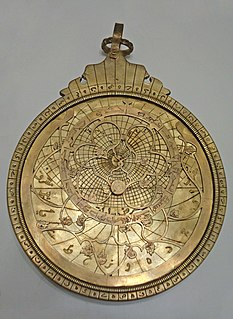Related Research Articles

Brass is an alloy of copper and zinc, in proportions which can be varied to achieve varying mechanical and electrical properties. It is a substitutional alloy: atoms of the two constituents may replace each other within the same crystal structure.

Steel is an alloy of iron with typically a few tenths of a percent of carbon to improve its strength and fracture resistance compared to iron. Many other elements may be present or added. Stainless steels that are corrosion- and oxidation-resistant need typically an additional 11% chromium. Because of its high tensile strength and low cost, steel is used in buildings, infrastructure, tools, ships, trains, cars, machines, electrical appliances, and weapons. Iron is the base metal of steel. Depending on the temperature, it can take two crystalline forms : body-centred cubic and face-centred cubic. The interaction of the allotropes of iron with the alloying elements, primarily carbon, gives steel and cast iron their range of unique properties.

Recycling is the process of converting waste materials into new materials and objects. The recovery of energy from waste materials is often included in this concept. The recyclability of a material depends on its ability to reacquire the properties it had in its virgin or original state. It is an alternative to "conventional" waste disposal that can save material and help lower greenhouse gas emissions. Recycling can prevent the waste of potentially useful materials and reduce the consumption of fresh raw materials, thereby reducing: energy usage, air pollution, and water pollution.

An ingot is a piece of relatively pure material, usually metal, that is cast into a shape suitable for further processing. In steelmaking, it is the first step among semi-finished casting products. Ingots usually require a second procedure of shaping, such as cold/hot working, cutting, or milling to produce a useful final product. Non-metallic and semiconductor materials prepared in bulk form may also be referred to as ingots, particularly when cast by mold based methods. Precious metal ingots can be used as currency, or as a currency reserve, as with gold bars.

Scrap consists of recyclable materials left over from product manufacturing and consumption, such as parts of vehicles, building supplies, and surplus materials. Unlike waste, scrap has monetary value, especially recovered metals, and non-metallic materials are also recovered for recycling.

Downcycling, or cascading, is the recycling of waste where the recycled material is of lower quality and functionality than the original material. Often, this is due to the accumulation of tramp elements in secondary metals, which may exclude the latter from high-quality applications. For example, steel scrap from end-of-life vehicles is often contaminated with copper from wires and tin from coating. This contaminated scrap yields a secondary steel that does not meet the specifications for automotive steel and therefore, it is mostly applied in the construction sector.
Plastic recycling is the process of recovering scrap or waste plastic and reprocessing the material into useful products. Due to purposefully misleading symbols on plastic packaging and numerous technical hurdles, less than 10% of plastic has ever been recycled. Compared with the lucrative recycling of metal, and similar to the low value of glass recycling, plastic polymers recycling is often more challenging because of low density and low value.
In metallurgy, non-ferrous metals are metals or alloys that do not contain iron (ferrite) in appreciable amounts.

Electronic waste or e-waste describes discarded electrical or electronic devices. Used electronics which are destined for refurbishment, reuse, resale, salvage recycling through material recovery, or disposal are also considered e-waste. Informal processing of e-waste in developing countries can lead to adverse human health effects and environmental pollution.

Aluminium recycling is the process by which scrap aluminium can be reused in products after its initial production. The process involves simply re-melting the metal, which is far less expensive and energy-intensive than creating new aluminium through the electrolysis of aluminium oxide (Al2O3), which must first be mined from bauxite ore and then refined using the Bayer process. Recycling scrap aluminium requires only 5% of the energy used to make new aluminium from the raw ore. For this reason, approximately 36% of all aluminium produced in the United States comes from old recycled scrap. Used beverage containers are the largest component of processed aluminum scrap, and most of it is manufactured back into aluminium cans.

Chemetco was formerly one of the largest United States refiners of copper from recycled or residual sources.
In metallurgy, refining consists of purifying an impure metal. It is to be distinguished from other processes such as smelting and calcining in that those two involve a chemical change to the raw material, whereas in refining, the final material is usually identical chemically to the original one, only it is purer. The processes used are of many types, including pyrometallurgical and hydrometallurgical techniques.
Zinc smelting is the process of converting zinc concentrates into pure zinc. Zinc smelting has historically been more difficult than the smelting of other metals, e.g. iron, because in contrast, zinc has a low boiling point. At temperatures typically used for smelting metals, zinc is a gas that will escape from a furnace with the flue gas and be lost, unless specific measures are taken to prevent it.

Oxhide ingots are metal slabs, usually of copper but sometimes of tin, produced and widely distributed during the Mediterranean Late Bronze Age (LBA). Their shape resembles the hide of an ox with a protruding handle in each of the ingot’s four corners. Early thought was that each ingot was equivalent to the value of one ox. However, the similarity in shape is simply a coincidence. The ingots' producers probably designed these protrusions to make the ingots easily transportable overland on the backs of pack animals. Complete or partial oxhide ingots have been discovered in Sardinia, Crete, Peloponnese, Cyprus, Cannatello in Sicily, Boğazköy in Turkey, Qantir in Egypt, and Sozopol in Bulgaria. Archaeologists have recovered many oxhide ingots from two shipwrecks off the coast of Turkey.

Umicore N.V.. formerly Union Minière, is a multinational materials technology company headquartered in Brussels, Belgium.
Plano-convex ingots are lumps of metal with a flat or slightly concave top and a convex base. They are sometimes, misleadingly, referred to as bun ingots which imply the opposite orientation of concavity. They are most often made of copper although plano-convex ingots of other materials such as copper alloy, lead and tin are also known. Plano convex ingots are found across a wide chronological and geographical range with the first examples known from the Near East during the 3rd and 2nd Millennia BC. By the end of the Bronze Age they were found throughout Europe and in Western and South Asia and similar ingot forms continue in use during later Roman and Medieval periods.
Products made from a variety of materials can be recycled using a number of processes.
A scrap metal shredder, also sometimes referred to as a metal scrap shredder, is a machine used for reducing the size of scrap metal. Scrap metal shredders come in many different variations and sizes.

Diehl Metall is a corporate division of the Diehl Stiftung & Co. KG, a worldwide operating industrial group with its head office in Röthenbach an der Pegnitz near Nuremberg, Germany. The production units of Diehl Metall are situated at 13 locations in Europe, Asia, South America and the US. With 3,420 employees the company generated a turnover of €917 million in 2017. Diehl Metall produces semi-finished products, forgings and rolled products, high-precision stamped parts with plating technologies as well as Schempp+Decker press-fit zones and metal-plastic compound systems. The company provides material development and production, sheet metal forming and forging technology as well as plating, press-fit, overmolding and assembling technology completely in-house.

The ISASMELT process is an energy-efficient smelting process that was jointly developed from the 1970s to the 1990s by Mount Isa Mines Limited and the Australian government’s Commonwealth Scientific and Industrial Research Organisation ("CSIRO"). It has relatively low capital and operating costs for a smelting process.
References
- ↑ Archived February 21, 2005, at the Wayback Machine
- ↑ "European Recycling Directory". euro.recycle.net. 2013-09-12. Retrieved 2013-10-12.
- ↑ "Tin Markets, Technology and Sustainability". ITRI. Retrieved 2013-10-12.
- ↑ "Bureau of International Recycling". BIR. Archived from the original on 2007-08-27. Retrieved 2013-10-12.